Category — Books
I HEART librarians

As a writer, a reader, a bibliophile, one who believes that literacy unlocks countless doors, one who believes that books change lives, I have been a life-long lover of libraries. Especially public libraries.
Brief pause for historical interlude: As with many wonderful ideas that happened a long time ago in this country, Benjamin Franklin figures into the library narrative. He founded the first one in the colonies, a lending library in Philadelphia in 1703. The country’s first free (which is to say, tax supported) public library opened in the spring of 1833 in Petersborough, New Hampshire. The more famous (and erroneously claimed as “first’) Boston Public Library opened its doors in 1852. Fun fact: In the 1890s, the city boosters of Butte, Montana opened that city’s public library “as an antidote to the miners’ proclivity for drinking, whoring and gambling.” (One wonders how that worked out for them.)
A few years later, the millionaire (when that meant something) governor of New York, Samuel Tilden, bequeathed a fortune to establish the extraordinary New York Public Library. And then there was Andrew Carnegie, industrialist-philanthropist, who funded the establishment of more than 2,500 libraries worldwide, 1,689 of them, each a gem, in the U.S. Today, in case you’re interested, we have more than 16,000 public libraries.
And now, back to the present (or, rather, five days ago):
I am signing advance readers’ copies of my soon-to-be published book, Free: Two Years, Six Lives and the Long Journey Home, at the Public Librarians Association annual convention. Sourcebooks, my extraordinary publisher (incidentally, the largest woman-owned publisher in North America) has a booth in the convention hall. There’s a line of librarians queuing up, the badges hanging from their necks identifying them as hailing from Alaska and Arkansas, Wyoming, Arizona, Louisiana, Denver, Boston, all over the Midwest.
In the thirty seconds or so I have to interact with each of them, I ask why they are interested in the book. I’m prepared for the usual answer: Adult nonfiction is a big category for us. I am not prepared for the personal responses: The references to family members or friends who have spent time behind bars and their difficult journeys back to their communities. And I am really not prepared to learn of their professional involvement, as librarians, in the lives of previously incarcerated in their communities.
These librarians see and talk with these folks every day. Some—far too many–who are released from prison are unhoused. On the streets at night, they find refuge during the day at the public library, a warm, dry place to sit, to read, to snooze. And yes, to use the bathroom. Some who are released go to temporary shelters or halfway houses or transitional housing, too often chaotic noisy places that can feel (and be) confusing or unsafe or both. A few hours of quietly sitting, undisturbed, in a public library is a respite.
The librarians I got to meet were on the frontline, aware of and sensitive to the challenges of reentry. More than a few talked about special programs they run or are creating to welcome and serve this population. “We are at the heart of our communities,” one Ohio woman told me. “We serve the entire community—and that means those who’ve spent time in jail and are now back home. We can model that for others.”
Oh librarians, how do I love thee? Let me count the ways.
The book I signed for them, the book you can pre-order now (publication date April 19):
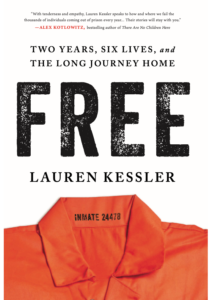
March 30, 2022 19 Comments
You missed me, right?
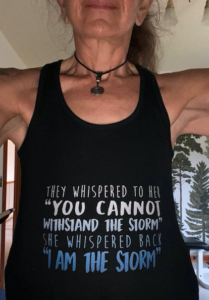
How come you haven’t been posting a little essay at your blog every week as you have for, like, forever? I’ve sure missed it.
Said no one.
But, since you didn’t ask, let me tell you: When I first started blogging 11 years ago—yes, that long ago—it was in support of my then just-about-to-be-released book, My Teenage Werewolf. The weekly posts were meant to gin up interest in the book and, as they say, “build my platform.” Neither of which happened. I then blogged my way through the next book, Counterclockwise, mostly because there was no end to the fascinating research coming out about health and aging, and I wanted to keep sharing it. Then there were the weekly stories connected to my next project, Raising the Barre, which I found time to write because the book was teaching me so much about humility and self-empowerment as I learned about the lives of those who lived their art. Research for the prison book, A Grip of Time, grabbed hold of me and wouldn’t let go, so I had to write about that even as I was writing the book.
But the blog also became a place where I could write about writing and, during those dark Trumpian years, about politics, about holding on to a semblance of sanity, about not losing hope. The weekly stories became part of my writing discipline. I no longer thought about “platform building” or driving sales or–forgive me, I actually had this fantasy back in 2010– “going viral.”
Lately, though, not that you noticed, I have not been posting regularly. Work on the new book, which I hope will be titled Time After Time, has taken over. (Four weeks and counting to manuscript deadline.) Add to that the work-on-top-of-work it has been to conceptualize, refashion and reboot four writing workshops and a graduate seminar to the virtual classroom.
And then there’s the psychic energy drain of living through the final dangerous days of Trump and the never-ending months (now a year) of the pandemic.
Anyways, my friends, I am back. At least for the moment. And while I have your undivided attention (all 3 of you), I wanted to share this link to an interview I did recently with the 1200-member Aviatrix Book Club about The Happy Bottom Riding Club. That book, one of two biographies I’ve written (published, yikes, 20 years ago), has recently—and mysteriously—been getting renewed attention. There’s this book club, and then another female pilot book club before that, and a film option. It’s nice that old books never die. I am reminded of that final scene in The Happy Bottom Riding Club, possibly my favorite in the book. If you know it, you know just what I mean. I am not, however, covered in ashes.

March 3, 2021 4 Comments
A Nutcracker-less Year
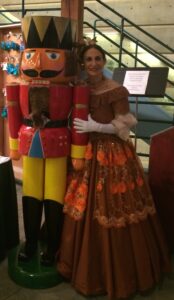
Maria Tallchief danced the Sugar Plum Fairy. Andre Eglevsky was the Cavalier. It was my first Nutcracker. I was five. I had no idea who they were or how incredibly lucky I was to be in that audience. All I knew was: WOW. All I knew was: I WANT TO DO THAT.
My mother, who took me to that performance and to Nutcrackers for the next thirteen seasons, understood. I started ballet lessons with Professor Troyanoff (who may or may not have been an actual professor) when I was six. When I was almost eleven, I began taking lessons from Andre Eglevsky, (yes, him) who had just retired from Balanchine’s New York City Ballet. At twelve, I was–as the saying goes–drummed out of the corps. Eglevsky told my mother to stop wasting her money. I had the wrong body. I would never be a dancer.
What those words did to me, and what I did to recapture the dream I had of dancing in The Nutcracker became my book, Raising the Barre. I had to write it.
This is my first Nutcracker-less year (either in the audience or on stage) since I was five. I miss it terribly. In this year of missing so much, this is near the top of the list.
And so I am listening to Moscow Symphony Orchestra’s production of Tchaikovsky’s sumptuous score as I post these images of my time with the talented, hard-working, generous and oh-so-kind Eugene Ballet Company dancers who inspired me, taught me, and let me into their lives.
Stretching out in company class
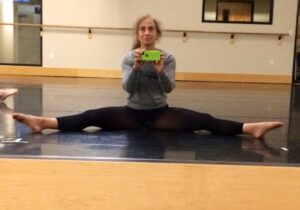
The ever-patient Mark Tucker (in background) and his partner in dance and life, Danielle Tolmie, taught me the Grandfather Dance (my 15-seconds of center-stage glory).
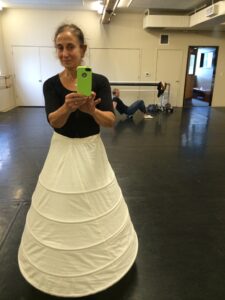
The glamor (not) and excitement of the backstage dressing room. (That’s Victoria Harvey, who took me stage make-up shopping. Suzanne Haag taught me the magic.)
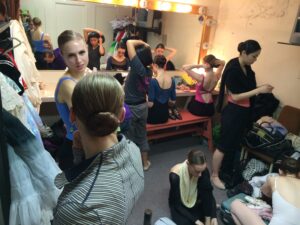
Warming up before a Hult Center performance
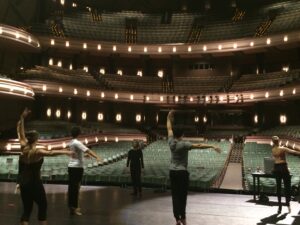
My friend, wing-woman, Ballet Book Club and leotard-shopping partner, Kim Sheehan.
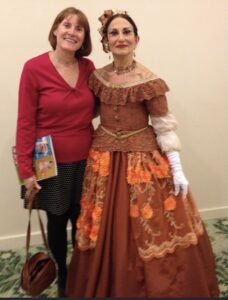
December 20, 2020 1 Comment
Look! A new look!

Welcome to my new look!
Well, not me personally. I am still wearing my hair long, parted down the middle, as I have since phones were attached to walls. I am still the fashion plate I have always been: jeans and t-shirts (fancy wear) or (since COVID) work-out clothes (that, more times than not, I don’t change out of all day).
And I still blog, posting every Wednesday, as I have for the past…yikes…ten years. (Estimates for the average lifespan of a blog range from 100 days to 2.6 years, with the higher-end populated by commercial ventures.) This blog, laurenchronicles, has had other names–counterclockwise when the site focused on the science of aging and separating hope from hype; thinhouse when the site focused on our deeply researched, well-intentioned but ultimately unaffordable plans to live a carbon-neutral life; myteenagewerewolf when I was riding the rollercoaster of mothering a teen girl. Creating the umbrella of laurenchronicles several years ago gave me the freedom to write about everything from the elegant (and sweaty) world of ballet to the hidden world of maximum security prisons, from the joys and deep pleasures of community activism to the anger and fear of living in Trump’s America. The blog, whatever it has been called and whatever I decided to write about that week, was never (and will never be) monitized. Maintaining and writing it is not about “platform-building.” It was, it is, a weekly discipline, a commitment to sort through and order my thoughts, to practice telling stories, little ones, to reach out and engage with readers.
I thought it was about time for a new look for the blog, something with a bit more energy and color, something that represented and celebrated what I love. And I knew just the person to design it: a super-talented, delightfully creative, engagingly collaborative illustrator/ graphic designer, Liza Burns, my daughter from another mother.
So here it is.
And to mark the launch of the new banner–a contest! Want a free, autographed book? Of course you do!
Here’s what to do: Take a look at the banner. Identify any 5 items and in a new words explain the significance of each to me. Then either PM or email me this response. Don’t post here! The first 3 people to identify and correctly explain 5 items will get an autographed book of their choice. (Choices are Grip of Time, Raising the Barre or Counterclockwise.) Contest ends noon on Friday.
Do it! Also visit Liza’s portfolio site for a visual treat.
October 14, 2020 No Comments
Women’s Work
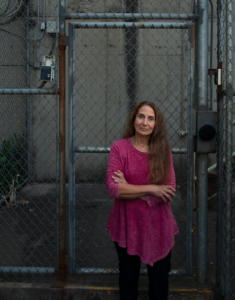
Women’s Work is a powerful, stunning book that chronicles–in extraordinary photographs and inspiring text–the lives and work of more than sixty women. They are funeral directors and firefighters, pig farmers and blacksmiths, pilot and cowgirls, ranch owners, gold miners, beekeepers. I am honored to be included. People are always saying/ writing about how they are “honored” to be included or mentioned or to have won something. This is the common parlance of the so-called Humble Brag that we see on Facebook, which I hope you despise as much as I do.
So let me explain the sincerity of my being “honored.” The photographer whose vision—intellectual, cultural, artistic—shaped this book is an exceptional talent, the kind of talent that does not have to announce itself, that works quietly and intensely and humbly. Being in his presence, being the object of his gaze for this photo shoot was the first honor. (We had worked together several years before when he flew west to do a photo shoot for Prevention magazine story I wrote.)
The other honor is the more obvious one: These women! Their energy, their boldness, their perseverance, their commitment. The authority in their faces. The strength of their bodies. To be in the their midst empowers me. I was selected not because my work as a writer breaks gender stereotypes but because of my work teaching writing in a maximum security penitentiary to convicted murderers and my book chronicling the lives they live inside.
The photography is all Chris Crisman’s. The accompanying text is written by the women themselves. I think the mix is a wham-bang.
About my image: It was made on the grounds of Oregon State Penitentiary, just to the right of the entrance. We had hoped to shoot inside, or at least by the release gate, but that was not to be. My time inside, including close to one hundred writing group sessions with the men over a period for four years, was often filled with humor. But I did not want to smile for this photograph. Prison is a hostile, toxic environment. Those who survive, those who change and transform—like many of the writers I worked with—do so despite not because of their years of punishment. This is what is uplifting and energizing: these stories of transformation.
March 4, 2020 2 Comments
Books of the decade
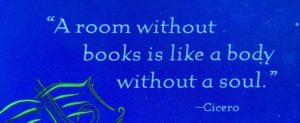
Here’s a bit of joyous end-of-the-decade news for those who write books, read books, love books, help bring books into the world (yes you, Heather Jackson):
According to the global information company, The NPD Group, 6.5 billion print books were sold this decade. (Add to that 1.8 billion e-books.) You may remember that e-books were supposed to wipe out print books? Didn’t happen. I love everything about physical books but really I don’t care HOW people read books. I care that they read.
And I care WHAT they read.
About that. I am sorry to report that these were top ten bestsellers of the decade.
1. Fifty Shades of Grey, by E. L. James: 15.2 million copies
2. Fifty Shades Darker, by E. L. James: 10.4 million copies
3. Fifty Shades Freed, by E. L. James: 9.3 million copies
4. The Hunger Games, by Suzanne Collins: 8.7 million copies
5. The Help, by Kathryn Stockett: 8.7 million copies
6. The Girl on The Train, by Paula Hawkins: 8.2 million copies
7. Gone Girl, by Gillian Flynn: 8.1 million copies
8. The Fault in Our Stars, by John Green: 8 million copies
9. The Girl with the Dragon Tattoo, by Stieg Larsson: 7.9 million copies
10. Divergent, by Veronica Roth: 6.6 million copies
What occurred to you as you scanned that list? Here’s what occurred to me:
Wow. These books were all movies. Hollywood’s effect on book sales is EXTRAORDINARY and out of proportion.
Wow. I read many many books, and I’ve read only ONE of these decade bestsellers (The Help). I did, however, see 4 of the movies—although not the movie made from the book I read.
Wow. Apparently tens of millions of readers are attracted to dystopian visions of the future. But we are currently LIVING a dystopian vision, so I am spectacularly uninterested in (and right now downright averse to) steeping myself in this genre. (I’m glad I read The Handmaid’s Tale in 1985 when I didn’t feel the world was as poisonous as it now feels to me.)
Wow. Not to be overly judgmental about it…well, okay, why not be as judgmental as I want to be…but Fifty Shades? Really? Such unadulterated (ha, almost a pun in there somewhere) crap. A nubile girl-woman. A privileged asshole of a rich man. BDSM. Aren’t we capable of having better quality fantasies than this?
Wow. These books are all fiction. But nonfiction is a much, much MUCH bigger category—both in numbers of books published and in total revenue. For example, adult non-fiction revenue totaled $6.18 billion across the publishing industry in 2017, while adult fiction revenues reached $4.3 billion, according to data from Association of American Publishers (AAP), the U.S. Bureau of Economic Analysis, and Bookscan.
So much for the past decade. What’s on your welcome-to-the-new decade reading list?
December 31, 2019 6 Comments





